Evil Cooper’s blackmailing worked like a charm. He, and his associate Ray, are free to prowl the night for tricks. But if Darya’s role was any indication, Ray’s loyalty to Mr. C is a facade. As far as we know, both Darya and Ray are acting under Phillip Jeffries’ orders to eliminate Mr. C. Whether or not he knows of Ray’s true allegiance is a mystery. In case he does, he may consider taking out Ray pretty soon. In spite of the mystery behind Mr. C’s ultimate goal, this affair will prove plain and mundane in comparison to what will unfold this episode. This will be a sequence of hidden origins behind events we’ve known. But it doesn’t do to simply tell us.
Some say that David Lynch is a painter practicing his art on the medium of cinematography. He has proven this claim true time after time, but few times as strongly as now. This time, most of the narration unfolds without a word. It will most certainly be a monstrously beautiful series of events, and if Eraserhead is dear to you, you’ll most certainly feel at home – a mortifying, nightmarish home. Brace yourself.
Beneath the flesh
The ambience is rather tense inside of the car as Ray and Mr. C drive on the highway. It’s just as well since both parties hold different agendas under the guise of cooperation. Naturally, evil Coop’s not telling him he killed Darya for conspiring to kill him. After disabling the tracking devices on the vehicle, he instructs Ray to drive to a place known as “The Farm.” Meanwhile. we learn that one of the reasons bad Coop has freed Ray is because he has something he wants – a password, apparently, which Ray considers worth plenty of money. This subtle hint at extortion is useful to darken the mood a little more. A visual reprisal of the ominous road at night from Lost Highway ensues as Ray pulls over to “take a leak”.
Mr. C takes his chance to hold Ray at gunpoint, to extort the information out of Ray, at a currency of bullets. However, the compromising position of urinating outside was a ruse to lure him into a false sense of leverage. Turns out he had unloaded evil Coop’s gun beforehand. Ray shoots him twice, and is about to shoot a third when the uncanny breaks into the scene. A large bunch of ethereal soot ‘woodsmen’ surround the Doppelganger, making a bloody mess of the body, while Ray looks on, understandably freaked out. The scene is nowhere as gruesome as the death of Sam and Tracey back in Part 1. And we hardly feel any sorrow for this turn of events, especially considering what the Woodsmen’s work reveals beneath Mr. C’s flesh.
BOB.
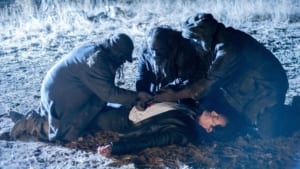
Later that night, Ray drives away from the site as he leaves a message to Phillip Jeffries. In spite of the bullets, and the blood, Ray is not entirely sure the Doppelganger is truly dead. Actually, he interprets the Woodsmen intervention as an aid of sorts. He goes on to say that BOB’s ‘presence’ inside of the Doppelganger may be the key to it all. This begs the question, could Jeffries, Ray and Darya be acting as a force of good? There is room to believe so, but if Fire Walks With Me has taught us anything, it’s that any deed could be twofold when the Black Lodge is involved.
The floodgates break open
In a peculiar change of pacing, we maintain the tone of the previous scene with a musical performance at the ROADHOUSE (no longer the Bang Bang Bar, for reasons explained in the previous recap). Whereas past performances have mostly resonated on warmer, more melodic genres, this time, it’s downright industrial, cold and gritty. It’s one of Lynch’s favourites, “The” Nine Inch Nails, performing “She’s Gone Away“, featuring Mariqueen Maandig. Safe to say, the cavernous reverberation and theme of this performance maintains the oppressive mood. Even the choice in song and lyrics may feel like somewhat of a grim foreshadowing, as well as a reference to the ‘unearthing’ of Laura Palmer’s body and the effect her death had on the town.
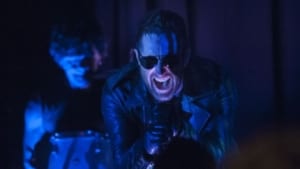
At the end of the performance, we return to the field where Mr. C was shot. The Doppelganger wakes up with clear and ominous intent in mind, especially after his associate’s betrayal.
Immediately after, we are taken to another time and place. It’s July 16, 1945 in White Sands, New Mexico. It’s the site where the first atomic bomb was detonated. The scene is entirely grey and black during the countdown, and a stark flash of white triggers at the end, along with the first frightful cords of “Threnody to the Victims of Hiroshima” by Polish composer Krzysztof Penderecki. Talk about monstrously fitting. The elevating mushroom cloud in slow motion and terrifying detail, as well as the knowledge of what will occur less than a month later, make this truly a nightmarish sequence. One might remember Director COLE has a framed picture of this event in his office. It might or not be a purely stylistic choice.
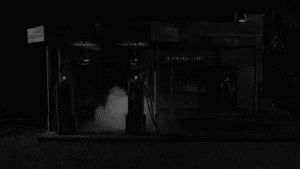
The terror continues as the camera zooms into the cloud. Several visual abstract compositions of chaos and destruction follow as the music goes on. At this point, colour has poured wildly into the black and white, but it only accentuates the violence on the senses. These special effects are nowhere nearly as impressive or disorienting as, say, Marvel’s Doctor Strange, but they don’t really need to be. At the end of this visual tidal wave, we find ourselves outside the Convenience Store, perhaps the only place more mysterious than the Black Lodge proper. We hear strange static sound effects as lights flash inside. Suddenly, we see a figurative swarm of Woodsmen roaming the place restlessly. This place appears to be their dwellings.
Births in Chiaroscuro
The camera draws the viewer’s eye towards a pipe in the vicinity of the building. On the other side, we see the Experiment from the glass box in Part 1 floating in a black void. Suddenly, it spews a long mass of grey fluid, with one single black globule brandishing the face of BOB. Within this stream of fluid, we return to the moment of devastation when the atomic bomb detonated. The structure of these scenes hint to a relation of cause and consequence and simultaneous unfolding. Inside of the chain of explosions, we see a golden orb much like what the real Dougie became upon returning to the Black Lodge.
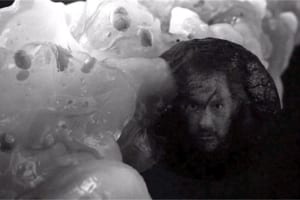
We are then transported to a building in the middle of the Purple Sea. This is not where Cooper found his way back into our world in Part 3. This building is much larger, like a fortress. The world inside this fortress is also black and white, so we may identify it as the place where the Return started. We see a character called Senorita Dido (Joy Nash) listening to a music on a gramophone. The ambience here is as calm as it could possibly be, given the circumstances, but a sudden clanking alarm-like sound prompts an old friend to make an appearance. We first met this character back in Season 2 and we knew him as The Giant throughout. However, the revival dubs him as ???????. There is yet a possibility that The Giant and ????? are not actually one and the same, so we’ll refer to this tall individual as ???????
The alarm prompts ??????? to walk across several locations in the fortress until he arrives at a projection room. Lynch connoisseurs may recognise this place as the set for Club Silencio in Mulholland Drive. It’s here that ??????? witnesses the detonation of the atomic bomb, the restless pacing of the Woodsmen and BOB’s ‘birth’. This last event may have greatly troubled ???????, and thus he ascends up into the air as a golden cloud forms about his head. It’s worth mentioning that the music for this scene is somewhat reminiscent of “The Voice of Love” from Fire Walk With Me, which yields a benign connotation to the process. Senorita Dido looks on in wonder as the cloud takes the form of a golden orb.
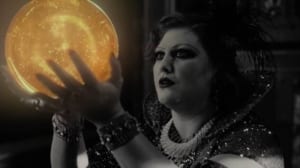
Senorita Dido holds this orb in her hands like a crystal ball, and within, she sees the face of Laura Palmer. After she kisses the orb, it ascends towards a device that sends ‘Laura’ to Earth. In spite of the absolute – for lack of a better term – tenderness of this development, there is a chance it could muddle the coherence of Twin Peaks‘ narrative foundation. By establishing Laura’s spiritual birth in conjunction with BOB’s, the narrative of the original seasons acquires a tone of fatefulness. This may not fall favourably in the eyes of those who appreciated the deconstructional tone of the suburban family masquerading a very realistic brand of horror. Nonetheless, it’s still just one small inkling of certainty we got when myriads questions yet toil around us.
A mantra of doom
Back in New Mexico. This time, it’s August 5, 1956. An egg – perhaps a product of the Experiment’s spewing – hatches in the desert. A strange frog-moth creature comes out of the broken shell. Elsewhere in the region, a girl and a boy walk together, all pretty harmless so far. The young woman (Tikaeni Faircrest) finds a penny face up, which some say it’s good luck. Unfortunately, an external event will prove her regrettably wrong. Meanwhile, a pair of Woodsmen appear in the desert. They stop a car on the road, and one of them heads towards the driver’s window. When a character has been silent for most of their appearances, listening to them speak can be somewhat off-putting. That is a massive understatement in this case.
The words “Got a light?” have never sounded so alien and wrong before. The couple in the car drive away, utterly frightened by these sooten fellows. Meanwhile, the young couple continue their nightly stroll to the girl’s home. At the end of it, they part through the old custom of a kiss goodbye. True to that stage of early adolescence, the kiss is supremely awkward. Nonetheless, the girl walks in to chill in her room, listening to “A Prayer” by the Platters, as you do. As viewers, we can at least be thankful she and her boy friend never ran into the Woodsmen, but we can’t say the same about the people who run the local radio station.
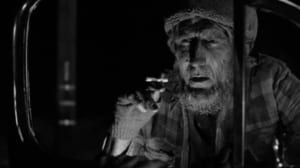
In an ominous fashion of soundtrack dissonance, the lovely tune plays on the background as a Woodsman walks into the station and gruesomely kills the receptionist, repeating “Got a light?” all the way. The anthropomorphic-but-definitely-not-human creature incapacitates the disc jockey and stops the record. He takes the microphone and speaks with his deep, gravelly voice: “This is the water. And this is the well. Drink full and descend. The horse is the white of the eyes and dark within.” Make out what you will of them, though we’ll surely find out eventually. The woodsman repeats these words as everybody listening to KPJK falls unconscious to their sound.
As this baleful mantra works its effect, the creature that hatched from the egg arrives to its destination. It flies in through the girl’s window, and crawls inside of her through her mouth. So much for good luck there. Finally, the Woodsman finishes killing the disc jockey by crushing his skull. The deed is done, and the purpose fulfilled. And after the Woodsman walks out into the unknown, we starting hearing the whinnying of a horse in the unseen distance. As the credits roll, the last thing we see is the girl sleeping on her bed. An odd whirring sound like the fluttering of an insect’s wings continues as a shadow moves in the corner. Her sleep is by no means peaceful.
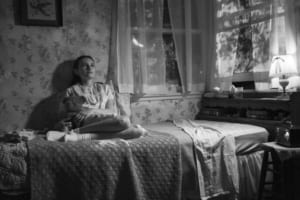
Thusly, this episode comes to an end in perhaps the most disturbing moment, so far. For every bit of knowledge we got this time, we also got a grand shadow of mystery. Alas, it does seem like we can start piecing together some theories, considerably more solid than two or three episodes ago. The bulk of narrative sandwiched between two parts taking place in the world we can apprehend has given us some food for thought. Just enough to wonder if this girl, who now carries the byproduct of the Experiment’s refuse, will harbour some of that unnaturalness within. Could it be that she might birth BOB? No telling yet, but one thing is certain…
In this narrative, it was the detonation of the atomic bomb what unleashed this phenomena. And make no mistake, these devices were always meant to kill, in large and definite measures, without distinctions of any kind. Plain and simple, it’s the epitome of the evil that men do. It matters little if this unfortunate girl will birth him, BOB was man-made.
Twin Peaks: The Return – Part 8 Credits
Directed by David Lynch
Written by Mark Frost and David Lynch
All images are courtesy of Showtime

